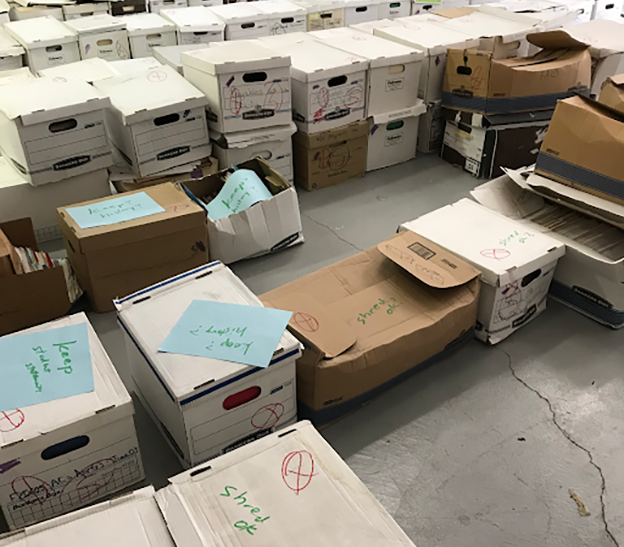How to speak the archive
A cross-pollination with Eleni Sikelianos

We invited all of the panelists from the June 11, 2012 “Archival Poetics and the War on Memory” event at Naropa to respond or expand on their contributions to the panel, as well as to respond to the Naropa archives and their poetic practice. Here are Eleni Sikelianos’s comments.
Jaime Groetsema/Amanda Rybin Koob: How has working with the Naropa Archive changed/influenced your understanding of archives/archival theory/archival practice?
Eleni Sikelianos: I would have to say that my conscious notion of the archive came into being at Naropa, when I first came to visit in 1988 when I was twenty-three years old, and then as a student there from 1989–1991, and later as a faculty member. Allen and Anne were both extremely attentive to keeping track of what was written, and what was said. Anne is always famously announcing, “into the mic, for the archive,” and I remember Allen advising in one of his workshops that to be a serious poet you had to keep track of your notebooks. Maybe these seemed like quirks you went along with as a young poet, but now in my late fifties I understand what it means to be a record-keeper of an art form that the state is not interested in keeping track of.
Later, I realized that I’d always had an interest in the secrets of the archive, digging into letters my mother kept in the closet, combing through old photos stuffed into envelopes and boxes.
Groetsema/Rybin Koob: How does your writing/creative practice overlap with the material objects that archives contain?
Sikelianos: All my writing practices are rooted in archives. My family histories/anti-histories draw from photographs, documents, but also from dresses my great grandmother designed and wove, as well as the loom she wove them on, or costumes my burlesque-dancer grandmother made.
I’ve just finished a book, Your Kingdom, that riffles through the bodily archive and all we’ve inherited genetically, formally, and behaviorally from other animals. Besides the material archive of bodily forms, I was inspired by many things, including the glass figures created by the Bohemian father-and-son team Leopold and Rudolf Blaschka. In the days before widespread aquaria, before specimens could easily be shipped to places of study, they made over ten thousand scientifically accurate, beautiful glass models of seven hundred marine species, which were sent all over the world instead of dead or soon-to-be-dead animals. They also made exquisite plants and flowers, some of which can be seen at the Harvard Museum of Natural History, where I was taken into the pristine underground chambers, where drawer-upon-gleaming-steel-drawer is filled with their refurbished models. Some are also held in the Corning Museum of Glass, and photos of these can be seen at the Cornell University Library Digital Archives.
Groetsema/Rybin Koob: Would you add or change anything from your comments in the “Archival Poetics and the War on Memory” panel?
Sikelianos: First, I loved listening to the archive again: thank you for that invitation.
Since that panel, we have been through the Trump administration and the war not just on memory, but also on fact. Social media has taken over a huge piece of our mental landscapes. We have the specter of hate language and cancel language being wielded in large swathes of “public” space. We are still in the throes of the Reckoning with American history, set into more urgent motion by George Floyd’s hideous murder. And the eminent destruction of so much animal and plant memory is more pressing than ever. All these forces are shaping our approach to memory and the archive, and it can be excruciating to find a posture from which to use language, to know how to speak.
During Trump’s reign, I felt assaulted by what I perceived as the collision of “alternative facts” and the work of the imagination. Finally, I was able (through the help of other writers) to clarify the situation for myself: “alternative facts” are meant to close thinking down and the work of the imagination is to expand it. Now I want to reclaim “alternative facts” for the poets, because we have always been trafficking in them, but for very different reasons, and to very different effect.
Last night, I read a passage in Natalia Ginzburg’s Family Lexicon (translated by Jenny McPhee) that spoke to me deeply. The book is an account of a family (Jewish and Gentile) in an era that included the rule of Mussolini. She is speaking here about the period just after the war.
Everyone thought we could, or rather should, write poetry about any and all subjects since for so many years the world had been silenced and paralyzed, reality being something stuck behind glass — vitreous, crystalline, mute, and immobile. Novelists and poets had been starved of words during the fascist years. So many had been forbidden to use words, and the few who’d been able to use them were forced to choose them very carefully from the slim pickings that remained. During fascism, poets found themselves expressing only an arid, shut-off, cryptic dream world. Now, once more, many words were in circulation and reality appeared to be at everyone’s fingertips. So those who had been starved dedicated themselves to harvesting the words with delight. And the harvest was ubiquitous because everyone wanted to take part in it. The result was a confused mixing up of the languages of poetry and politics. Reality proved itself to be complex and enigmatic, as indecipherable and obscure as the world of dreams.
A few years ago, I dreamt of a burning tree of language, unacceptable words being burned with each leaf, and the dream’s concern was: now how will we express reality? That is the ongoing work of the poet, to figure that out.
Community Praxis in Naropa Audio Archives